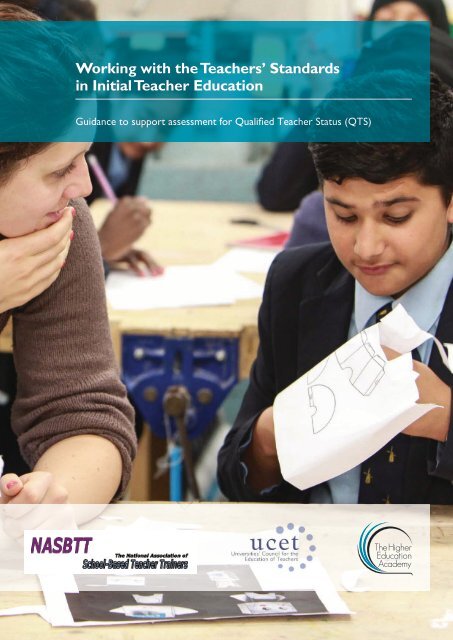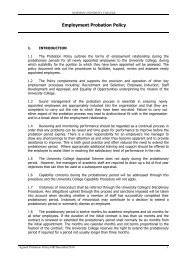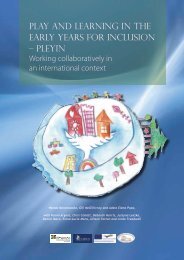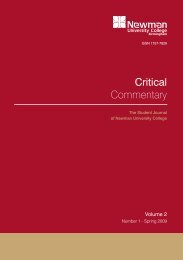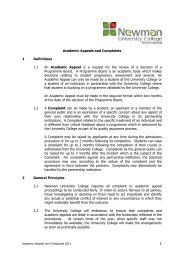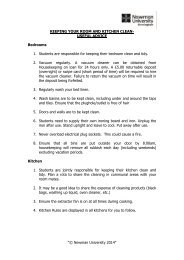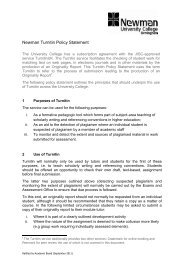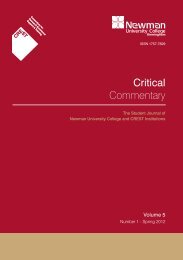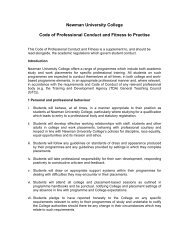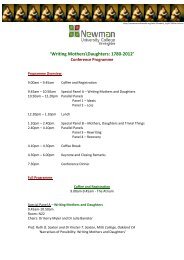Working with the Teachers' Standards in Initial Teacher Education
Working with the Teachers' Standards in Initial Teacher Education
Working with the Teachers' Standards in Initial Teacher Education
Create successful ePaper yourself
Turn your PDF publications into a flip-book with our unique Google optimized e-Paper software.
2 Us<strong>in</strong>g <strong>the</strong> guidance2.1 The guidance has been developed as a service to <strong>the</strong> ITE sector through acollaborative process, <strong>in</strong>volv<strong>in</strong>g both HEI-based and school-based providers. It is <strong>in</strong>tendedto provide a consistent po<strong>in</strong>t of reference for models of formative and summativeassessment made at local level and for any additional materials developed to supporttra<strong>in</strong><strong>in</strong>g for specific age phases, curriculum areas or <strong>the</strong>mes <strong>in</strong> tra<strong>in</strong><strong>in</strong>g <strong>in</strong>clud<strong>in</strong>g SEN andbehaviour.2.2 The guidance does not detail how specific aspects of achievement may be evidenced.In practice this is likely to <strong>in</strong>clude classroom observations, lesson plans, teach<strong>in</strong>g files,self-evaluations, profiles, subject knowledge audits, records of feedback, assignmentsand completed directed tasks. Some providers may choose to deploy dist<strong>in</strong>ctiveand <strong>in</strong>novative means of evidenc<strong>in</strong>g achievement. For this reason <strong>the</strong> guidance is notprescriptive.2.3 The statements <strong>in</strong> <strong>the</strong> guidance set out <strong>the</strong> m<strong>in</strong>imum standard that can reasonably beexpected of <strong>the</strong> tra<strong>in</strong>ee teacher at <strong>the</strong> po<strong>in</strong>t of recommendation for <strong>the</strong> award of QTS.All tra<strong>in</strong>ees recommended for <strong>the</strong> award of QTS must meet all of <strong>the</strong> standards atleast at this level. This is a demand<strong>in</strong>g standard <strong>in</strong> itself; never<strong>the</strong>less <strong>in</strong> order to achievecont<strong>in</strong>ued improvement <strong>in</strong> <strong>the</strong> quality of teach<strong>in</strong>g, <strong>the</strong> target should be to achieve good orbetter outcomes. The ITE tra<strong>in</strong><strong>in</strong>g programme must be designed to ensure that tra<strong>in</strong>eeshave <strong>the</strong> opportunity to demonstrate achievement of all of <strong>the</strong> standards, <strong>in</strong> some cases<strong>with</strong> appropriate support from experienced practitioners. It is expected that beg<strong>in</strong>nerteachers will have personal and pedagogical aspirations that will be met <strong>in</strong> <strong>the</strong> <strong>in</strong>ductionphase and subsequently through cont<strong>in</strong>u<strong>in</strong>g professional development.2.4 The <strong>Teacher</strong>s’ <strong>Standards</strong> are not graded. However, for <strong>the</strong> purposes of qualityimprovement, and <strong>in</strong> <strong>the</strong> context of <strong>the</strong> <strong>in</strong>spection of ITE, providers are required to gradetra<strong>in</strong>ees. The additional statements <strong>in</strong> relation to Part One of <strong>the</strong> <strong>Teacher</strong>s’ <strong>Standards</strong>set out typical characteristics of <strong>the</strong> practice of tra<strong>in</strong>ees deemed to be good, or of thosewho achieve <strong>the</strong> standards at a high level. Good and high achievement is a relativejudgement and will be based on an assessment of <strong>the</strong> available evidence to decide whichdescriptor provides <strong>the</strong> best fit and will take <strong>in</strong>to account <strong>the</strong> sett<strong>in</strong>g and context of <strong>the</strong>complementary school experiences <strong>in</strong> which <strong>the</strong> tra<strong>in</strong><strong>in</strong>g has taken place. Part Two of<strong>the</strong> <strong>Teacher</strong>s’ <strong>Standards</strong> relates to personal and professional conduct. Tra<strong>in</strong>ees embark<strong>in</strong>gon a programme of ITE will have demonstrated that <strong>the</strong>y possess <strong>the</strong> required attitudesand behaviours as an element of <strong>the</strong> selection process. No matter which route to QTS<strong>the</strong>y follow all tra<strong>in</strong>ees are expected to demonstrate high professional standards from <strong>the</strong>outset. For that reason <strong>the</strong> guidance on <strong>the</strong> standards <strong>in</strong> Part Two is not graded.2.5 In us<strong>in</strong>g <strong>the</strong> guidance providers will wish to cross refer to three key documents:• <strong>Teacher</strong>s’ <strong>Standards</strong>, DfE, May 2012:The def<strong>in</strong>itive version of <strong>the</strong> revised standards to be met by all teachers, whichreplace <strong>the</strong> previous QTS, Induction, and Core <strong>Standards</strong>, and <strong>in</strong>cludes an importantglossary expla<strong>in</strong><strong>in</strong>g term<strong>in</strong>ology;• <strong>Initial</strong> teacher tra<strong>in</strong><strong>in</strong>g (ITT) criteria, The Teach<strong>in</strong>g Agency, March 2012:This replaces <strong>the</strong> former ITT Requirements and <strong>the</strong> ITT Accreditation Criteria fromSeptember 2012, and sets out <strong>the</strong> criteria to which all ITT providers must comply;• <strong>Initial</strong> teacher education <strong>in</strong>spection handbook 2012, Ofsted, June 2012:This handbook sets out <strong>the</strong> framework for ITE <strong>in</strong>spections <strong>in</strong> England from September2012. It provides <strong>in</strong>structions and guidance for <strong>in</strong>spectors and outl<strong>in</strong>es what ITEpartnerships can expect, <strong>in</strong>clud<strong>in</strong>g guidance for <strong>in</strong>spectors <strong>in</strong> mak<strong>in</strong>g <strong>the</strong>ir judgements.In Section 3 of this document, text <strong>in</strong> <strong>the</strong> blue font <strong>in</strong>dicates it has been taken from<strong>Teacher</strong>s’ <strong>Standards</strong>, DfE, May 2012.’5
3 Guidance on <strong>the</strong> <strong>Teacher</strong>s’ <strong>Standards</strong><strong>Teacher</strong>s make <strong>the</strong> education of <strong>the</strong>ir pupils <strong>the</strong>ir first concern, and are accountablefor achiev<strong>in</strong>g <strong>the</strong> highest possible standards <strong>in</strong> work and conduct. <strong>Teacher</strong>s act <strong>with</strong>honesty and <strong>in</strong>tegrity; have strong subject knowledge, keep <strong>the</strong>ir knowledge and skillsas teachers up-to-date and are self-critical; forge positive professional relationships;and work <strong>with</strong> parents <strong>in</strong> <strong>the</strong> best <strong>in</strong>terests of <strong>the</strong>ir pupils.Part one: Teach<strong>in</strong>gA teacher must:S1 Set high expectations which <strong>in</strong>spire, motivate and challenge pupils• establish a safe and stimulat<strong>in</strong>g environment for pupils, rooted <strong>in</strong> mutual respect;• set goals that stretch and challenge pupils of all backgrounds, abilities and dispositions;• demonstrate consistently <strong>the</strong> positive attitudes, values and behaviour which areexpected of pupils.All tra<strong>in</strong>ees to be awarded QTS will have demonstrated as a m<strong>in</strong>imum that:They are able to encourage pupils to participate and contribute <strong>in</strong> an atmosphereconducive to learn<strong>in</strong>g. In <strong>the</strong> course of differ<strong>in</strong>g school experiences <strong>the</strong>y have shown that<strong>the</strong>y have set appropriately high expectations, believ<strong>in</strong>g that all pupils have <strong>the</strong> potential tomake progress. They are able to develop a rapport <strong>with</strong> a range of <strong>in</strong>dividuals and groups.As a consequence of this most pupils are engaged <strong>in</strong> <strong>the</strong>ir learn<strong>in</strong>g. They consistentlydemonstrate professional behaviour, respect for pupils, colleagues, parents and carers andsupport <strong>the</strong> ethos of <strong>the</strong> school. They demonstrate enthusiasm for work<strong>in</strong>g <strong>with</strong> childrenand young people and for teach<strong>in</strong>g and learn<strong>in</strong>g.Tra<strong>in</strong>ees achiev<strong>in</strong>g <strong>the</strong> standards at a good level may demonstrate <strong>the</strong>se characteristics:They are reliable <strong>in</strong> encourag<strong>in</strong>g pupils to participate and contribute <strong>in</strong> an atmosphereconducive to learn<strong>in</strong>g. They consistently set high expectations of pupils <strong>in</strong> <strong>the</strong>ir differenttra<strong>in</strong><strong>in</strong>g contexts.They are well respected by learners and effectively promote pupils’ resilience, confidenceand <strong>in</strong>dependence when tackl<strong>in</strong>g challeng<strong>in</strong>g activities. As a result of this most learners areenthused and motivated to participate.Tra<strong>in</strong>ees achiev<strong>in</strong>g <strong>the</strong> standards at a high level may demonstrate <strong>the</strong>se characteristics:They constantly encourage pupils to participate and contribute <strong>in</strong> an atmosphere highlyconducive to learn<strong>in</strong>g. They consistently set high expectations of pupils <strong>in</strong> different tra<strong>in</strong><strong>in</strong>gcontexts.6There are high levels of mutual respect between <strong>the</strong> tra<strong>in</strong>ee and pupils. They arevery effective <strong>in</strong> promot<strong>in</strong>g learners’ resilience, confidence and <strong>in</strong>dependence whentackl<strong>in</strong>g challeng<strong>in</strong>g activities. They generate high levels of enthusiasm, participation andcommitment to learn<strong>in</strong>g.
S2 Promote good progress and outcomes by pupils• be accountable for atta<strong>in</strong>ment, progress and outcomes of <strong>the</strong> pupils;• plan teach<strong>in</strong>g to build on pupils’ capabilities and prior knowledge;• guide pupils to reflect on <strong>the</strong> progress <strong>the</strong>y have made and <strong>the</strong>ir emerg<strong>in</strong>g needs;• demonstrate knowledge and understand<strong>in</strong>g of how pupils learn and how this impactson teach<strong>in</strong>g;• encourage pupils to take a responsible and conscientious attitude to <strong>the</strong>ir own workand study.All tra<strong>in</strong>ees to be awarded QTS will have demonstrated as a m<strong>in</strong>imum that:They understand how teachers are accountable for <strong>the</strong> atta<strong>in</strong>ment, progress andoutcomes of pupils and have taken some responsibility for this <strong>with</strong> guidance from <strong>the</strong>usual class teacher or o<strong>the</strong>r professional. Their short- and medium-term plann<strong>in</strong>g andteach<strong>in</strong>g demonstrate some understand<strong>in</strong>g of, and provision for, pupil progression tak<strong>in</strong>g<strong>in</strong>to account prior achievement. They support pupils <strong>in</strong> reflect<strong>in</strong>g on <strong>the</strong>ir learn<strong>in</strong>g andidentify<strong>in</strong>g <strong>the</strong>ir progress and emerg<strong>in</strong>g learn<strong>in</strong>g needs. When plann<strong>in</strong>g lessons <strong>the</strong>y devisesuitable opportunities for learners to evaluate and improve <strong>the</strong>ir performance. They areable to expla<strong>in</strong> how effective teach<strong>in</strong>g strategies are <strong>in</strong>formed by an understand<strong>in</strong>g of howpupils learn and offer a rationale for choices made <strong>in</strong> <strong>the</strong> context of practice. They planteach<strong>in</strong>g and learn<strong>in</strong>g activities that encourage <strong>in</strong>dependent and autonomous learn<strong>in</strong>g. As aconsequence all groups of pupils make at least satisfactory progress.Tra<strong>in</strong>ees achiev<strong>in</strong>g <strong>the</strong> standards at a good level may demonstrate <strong>the</strong>se characteristics:They assume responsibility for <strong>the</strong> atta<strong>in</strong>ment, progress and outcomes of <strong>the</strong> pupils <strong>the</strong>yteach. They demonstrate a sound understand<strong>in</strong>g of <strong>the</strong> need to develop pupil learn<strong>in</strong>gover time. Their short- and medium-term plann<strong>in</strong>g consistently takes <strong>in</strong>to account <strong>the</strong>prior learn<strong>in</strong>g of <strong>the</strong> pupils. They regularly provide pupils <strong>with</strong> <strong>the</strong> opportunity to reflecton <strong>the</strong>ir own learn<strong>in</strong>g and use this, along <strong>with</strong> o<strong>the</strong>r forms of assessment, to <strong>in</strong>form <strong>the</strong>irfuture plann<strong>in</strong>g and teach<strong>in</strong>g. They use <strong>the</strong>ir knowledge of effective teach<strong>in</strong>g strategies toencourage <strong>in</strong>dependent learn<strong>in</strong>g, and <strong>the</strong>y set appropriately challeng<strong>in</strong>g tasks that enable<strong>the</strong> learners to make progress. As a result <strong>the</strong> majority of pupils make good progress.Tra<strong>in</strong>ees achiev<strong>in</strong>g <strong>the</strong> standards at a high level may demonstrate <strong>the</strong>se characteristics:They assume a high level of responsibility for <strong>the</strong> atta<strong>in</strong>ment progress and outcomes of <strong>the</strong>pupils <strong>the</strong>y teach. They demonstrate confident judgement <strong>in</strong> plann<strong>in</strong>g for pupil progressionboth <strong>with</strong><strong>in</strong> <strong>in</strong>dividual lessons and over time and are able to articulate a clear and welljustifiedrationale as to how <strong>the</strong>y are build<strong>in</strong>g on prior achievement. They actively promoteengag<strong>in</strong>g and effective methods that support pupils <strong>in</strong> reflect<strong>in</strong>g on <strong>the</strong>ir learn<strong>in</strong>g. They areable to set appropriately challeng<strong>in</strong>g tasks, draw<strong>in</strong>g on a sound knowledge of <strong>the</strong> pupils’prior atta<strong>in</strong>ment, which has been obta<strong>in</strong>ed through systematic and accurate assessment.They regularly create opportunities for <strong>in</strong>dependent and autonomous learn<strong>in</strong>g. As a result<strong>the</strong> majority of pupils make very good progress.7
In relation to early read<strong>in</strong>g: primary tra<strong>in</strong>ees have a very secure knowledge andunderstand<strong>in</strong>g of syn<strong>the</strong>tic systematic phonics and its role <strong>in</strong> teach<strong>in</strong>g and assess<strong>in</strong>g read<strong>in</strong>gand writ<strong>in</strong>g <strong>in</strong> <strong>the</strong> context of <strong>the</strong> age phases <strong>the</strong>y are tra<strong>in</strong><strong>in</strong>g to teach.In relation to early ma<strong>the</strong>matics: primary tra<strong>in</strong>ees have a very secure knowledge andunderstand<strong>in</strong>g of <strong>the</strong> pr<strong>in</strong>ciples and practices of teach<strong>in</strong>g early ma<strong>the</strong>matics and employeffective teach<strong>in</strong>g strategies across <strong>the</strong> age ranges <strong>the</strong>y are tra<strong>in</strong><strong>in</strong>g to teach.Tra<strong>in</strong>ees achiev<strong>in</strong>g <strong>the</strong> standards at a high level may demonstrate <strong>the</strong>se characteristics:They draw on <strong>the</strong>ir <strong>in</strong>-depth subject and curriculum knowledge to plan confidentlyfor progression and to stimulate and capture pupils’ <strong>in</strong>terest. They demonstrate verywell-developed pedagogical subject knowledge, by anticipat<strong>in</strong>g common errors andmisconceptions <strong>in</strong> <strong>the</strong>ir plann<strong>in</strong>g. They are astutely aware of <strong>the</strong>ir own development needs<strong>in</strong> relation to extend<strong>in</strong>g and updat<strong>in</strong>g <strong>the</strong>ir subject, curriculum and pedagogical knowledge<strong>in</strong> <strong>the</strong>ir early career and have been proactive <strong>in</strong> develop<strong>in</strong>g <strong>the</strong>se effectively dur<strong>in</strong>g <strong>the</strong>irtra<strong>in</strong><strong>in</strong>g. They model very high standards of written and spoken communication <strong>in</strong> allprofessional activities. They successfully identify and exploit opportunities to developlearners’ skills, <strong>in</strong> communication, read<strong>in</strong>g and writ<strong>in</strong>g.In relation to early read<strong>in</strong>g: primary tra<strong>in</strong>ees draw on <strong>the</strong>ir very strong understand<strong>in</strong>g ofsyn<strong>the</strong>tic systematic phonics and its role <strong>in</strong> teach<strong>in</strong>g and assess<strong>in</strong>g read<strong>in</strong>g and writ<strong>in</strong>g toteach literacy very effectively across <strong>the</strong> age phases <strong>the</strong>y are tra<strong>in</strong><strong>in</strong>g to teach.In relation to early ma<strong>the</strong>matics: primary tra<strong>in</strong>ees draw on <strong>the</strong>ir very strong knowledgeand understand<strong>in</strong>g of <strong>the</strong> pr<strong>in</strong>ciples and practices of teach<strong>in</strong>g early ma<strong>the</strong>matics to select andemploy highly effective teach<strong>in</strong>g strategies across <strong>the</strong> age ranges <strong>the</strong>y are tra<strong>in</strong><strong>in</strong>g to teach.S4Plan and teach well structured lessons• impart knowledge and develop understand<strong>in</strong>g through effective use of lesson time;• promote a love of learn<strong>in</strong>g and children’s <strong>in</strong>tellectual curiosity;• set homework and plan o<strong>the</strong>r out-of-class activities to consolidate and extend <strong>the</strong>knowledge and understand<strong>in</strong>g pupils have acquired;• reflect systematically on <strong>the</strong> effectiveness of lessons and approaches to teach<strong>in</strong>g;• contribute to <strong>the</strong> design and provision of an engag<strong>in</strong>g curriculum <strong>with</strong><strong>in</strong> <strong>the</strong> relevantsubject area(s).All tra<strong>in</strong>ees to be awarded QTS will have demonstrated as a m<strong>in</strong>imum that:They employ a range of teach<strong>in</strong>g strategies and resources. They plan <strong>in</strong>dividual lessonsthat are appropriately structured to support pupils <strong>in</strong> develop<strong>in</strong>g <strong>the</strong>ir knowledge, skills,understand<strong>in</strong>g, <strong>in</strong>terest and positive attitudes. When teach<strong>in</strong>g <strong>the</strong>y ma<strong>in</strong>ta<strong>in</strong> <strong>the</strong> paceof <strong>the</strong> learn<strong>in</strong>g, are able to respond flexibly to what is happen<strong>in</strong>g <strong>in</strong> <strong>the</strong> classroom andhave <strong>the</strong> confidence to adapt <strong>the</strong>ir teach<strong>in</strong>g <strong>in</strong> order to respond to <strong>the</strong> needs of <strong>the</strong>learners. They can create an environment <strong>in</strong> which <strong>the</strong> learners are usually engaged. Theyunderstand how homework or o<strong>the</strong>r out-of-class work can susta<strong>in</strong> learners’ progress andconsolidate learn<strong>in</strong>g, and can design and set appropriate tasks. They review and reflect on<strong>the</strong>ir own plann<strong>in</strong>g and teach<strong>in</strong>g to prepare future activities and tasks that build on andsusta<strong>in</strong> progression <strong>in</strong> pupils’ learn<strong>in</strong>g. They work collaboratively <strong>with</strong> more experiencedcolleagues, where appropriate, to adapt and/or develop <strong>the</strong> school’s medium-term plans,schemes of work, and curriculum frameworks,9
Tra<strong>in</strong>ees achiev<strong>in</strong>g <strong>the</strong> standards at a good level may demonstrate <strong>the</strong>se characteristics:They show a will<strong>in</strong>gness to try out a range of approaches to teach<strong>in</strong>g and learn<strong>in</strong>g. Theyplan lessons that take account of <strong>the</strong> needs of groups of learners and <strong>in</strong>dividuals, through<strong>the</strong> sett<strong>in</strong>g of differentiated learn<strong>in</strong>g outcomes, carefully match<strong>in</strong>g teach<strong>in</strong>g and learn<strong>in</strong>gactivities and resources to support learners <strong>in</strong> achiev<strong>in</strong>g <strong>the</strong>se <strong>in</strong>tended learn<strong>in</strong>g outcomes.They know how to learn from both successful and less effective lessons through <strong>the</strong>irsystematic evaluation of <strong>the</strong> effectiveness of <strong>the</strong>ir practice, <strong>in</strong>clud<strong>in</strong>g its impact on learners.They make a positive contribution to <strong>the</strong> development of curriculum and resources <strong>in</strong><strong>the</strong>ir placement sett<strong>in</strong>gs.Tra<strong>in</strong>ees achiev<strong>in</strong>g <strong>the</strong> standards at a high level may demonstrate <strong>the</strong>se characteristics:They plan lessons that often use well-chosen, imag<strong>in</strong>ative and creative strategies, and thatmatch <strong>in</strong>dividuals’ needs and <strong>in</strong>terests. They are highly reflective <strong>in</strong> critically evaluat<strong>in</strong>g <strong>the</strong>irpractice. They can accurately judge <strong>the</strong> impact of <strong>the</strong>ir practice on <strong>in</strong>dividual and groupsof learners and can use <strong>the</strong>ir evaluation to <strong>in</strong>form future plann<strong>in</strong>g, teach<strong>in</strong>g and learn<strong>in</strong>g.They show <strong>in</strong>itiative <strong>in</strong> contribut<strong>in</strong>g to curriculum plann<strong>in</strong>g and develop<strong>in</strong>g and produc<strong>in</strong>geffective learn<strong>in</strong>g resources <strong>in</strong> <strong>the</strong>ir placement sett<strong>in</strong>gs.S5 Adapt teach<strong>in</strong>g to respond to <strong>the</strong> strengths and needs of all pupils• know when and how to differentiate appropriately, us<strong>in</strong>g approaches which enablepupils to be taught effectively;• have a secure understand<strong>in</strong>g of how a range of factors can <strong>in</strong>hibit pupils’ ability tolearn, and how best to overcome <strong>the</strong>se;• demonstrate an awareness of <strong>the</strong> physical, social and <strong>in</strong>tellectual development ofchildren, and know how to adapt teach<strong>in</strong>g to support pupils’ education at differentstages of development;• have a clear understand<strong>in</strong>g of <strong>the</strong> needs of all pupils, <strong>in</strong>clud<strong>in</strong>g those <strong>with</strong> specialeducational needs; those of high ability; those <strong>with</strong> English as an additional language;those <strong>with</strong> disabilities; and be able to use and evaluate dist<strong>in</strong>ctive teach<strong>in</strong>g approachesto engage and support <strong>the</strong>m.All tra<strong>in</strong>ees to be awarded QTS will have demonstrated as a m<strong>in</strong>imum that:They know <strong>the</strong> pupils well enough to recognise <strong>the</strong> different needs and strengths of<strong>in</strong>dividuals and groups and beg<strong>in</strong> to adapt <strong>the</strong>ir teach<strong>in</strong>g to address those needs andstrengths so that learners are supported towards achiev<strong>in</strong>g <strong>the</strong>ir potential. They are awareof a range of factors that are potential barriers to achievement and understand howexperienced teachers use a range of strategies to reduce <strong>the</strong>se barriers. They beg<strong>in</strong> todeploy <strong>the</strong>se strategies <strong>the</strong>mselves, work<strong>in</strong>g alongside experienced teachers and supportstaff as appropriate. They show awareness of how children and young people develop andtake account of this <strong>in</strong> <strong>the</strong>ir teach<strong>in</strong>g. They have some understand<strong>in</strong>g of <strong>the</strong> challengesand opportunities of teach<strong>in</strong>g <strong>in</strong> a diverse society. They have a develop<strong>in</strong>g understand<strong>in</strong>gof <strong>the</strong> needs of all pupils and are able to articulate dist<strong>in</strong>ctive teach<strong>in</strong>g approaches andstrategies needed to engage and support pupils <strong>with</strong> particular needs, <strong>in</strong>clud<strong>in</strong>g EAL andSEND. When <strong>the</strong> opportunity has arisen <strong>the</strong>y have used <strong>the</strong>se successfully and are able toevaluate <strong>the</strong> impact of <strong>the</strong> adaptations employed, on <strong>the</strong> progress of <strong>in</strong>dividual learners.Tra<strong>in</strong>ees achiev<strong>in</strong>g <strong>the</strong> standards at a good level may demonstrate <strong>the</strong>se characteristics:10They consistently adapt <strong>the</strong>ir teach<strong>in</strong>g to meet <strong>the</strong> needs of <strong>in</strong>dividual and groups oflearners to support progression <strong>in</strong> learn<strong>in</strong>g. They know how to secure progress forlearners and how to identify when groups and <strong>in</strong>dividuals have made progress. They havea range of effective strategies that <strong>the</strong>y can apply to reduce barriers and respond to <strong>the</strong>strengths and needs of <strong>the</strong>ir pupils. They clearly recognise how to deal <strong>with</strong> any potentialbarriers to learn<strong>in</strong>g through <strong>the</strong>ir application of well-targeted <strong>in</strong>terventions and <strong>the</strong>appropriate deployment of available support staff.
Tra<strong>in</strong>ees achiev<strong>in</strong>g <strong>the</strong> standards at a high level may demonstrate <strong>the</strong>se characteristics:They quickly and accurately discern <strong>the</strong>ir learners’ strengths and needs and are proactive<strong>in</strong> differentiat<strong>in</strong>g and employ<strong>in</strong>g a range of effective <strong>in</strong>tervention strategies to secureprogression for <strong>in</strong>dividuals and groups. They have an astute understand<strong>in</strong>g of how effectivedifferent teach<strong>in</strong>g approaches are <strong>in</strong> relation to impact on learn<strong>in</strong>g and engagement oflearnersS6 Make accurate and productive use of assessment• know and understand how to assess <strong>the</strong> relevant subject and curriculum areas,<strong>in</strong>clud<strong>in</strong>g statutory assessment requirements;• make use of formative and summative assessment to secure pupils’ progress;• use relevant data to monitor progress, set targets, and plan subsequent lessons;• give pupils regular feedback, both orally and through accurate mark<strong>in</strong>g, and encouragepupils to respond to <strong>the</strong> feedback.All tra<strong>in</strong>ees to be awarded QTS will have demonstrated as a m<strong>in</strong>imum that:They have a secure understand<strong>in</strong>g of <strong>the</strong> statutory assessment requirements for <strong>the</strong>subject/curriculum <strong>in</strong> <strong>the</strong> age phases <strong>the</strong>y are prepar<strong>in</strong>g to teach and are able to makebroadly accurate assessments aga<strong>in</strong>st national benchmarks. Their plann<strong>in</strong>g is characterisedby <strong>the</strong> use of a range of formative and summative assessment strategies, designed tosupport pupils <strong>in</strong> mak<strong>in</strong>g progress. They deploy <strong>the</strong>se strategies effectively <strong>in</strong> lessons, bothto evaluate <strong>the</strong> impact of teach<strong>in</strong>g on <strong>the</strong> progress of learners and as a basis for modify<strong>in</strong>g<strong>the</strong>ir teach<strong>in</strong>g and classroom practice when necessary. They understand how school- andpupil-level summative data are used to set targets for groups and <strong>in</strong>dividuals, and <strong>the</strong>yuse that knowledge to monitor progress <strong>in</strong> <strong>the</strong> groups <strong>the</strong>y teach. With guidance fromexperienced teachers, <strong>the</strong>y monitor pupil progress and ma<strong>in</strong>ta<strong>in</strong> accurate records, sett<strong>in</strong>gnew targets for <strong>in</strong>dividuals and groups. They mark pupils’ work constructively and provideappropriate oral feedback to pupils to help <strong>the</strong>m to make progress.Tra<strong>in</strong>ees achiev<strong>in</strong>g <strong>the</strong> standards at a good level may demonstrate <strong>the</strong>se characteristics:They are able to assess pupils’ atta<strong>in</strong>ment accurately aga<strong>in</strong>st national benchmarks. Theyemploy a range of appropriate formative assessment strategies effectively and can adapt<strong>the</strong>ir teach<strong>in</strong>g <strong>with</strong><strong>in</strong> lessons <strong>in</strong> light of pupils’ responses. They ma<strong>in</strong>ta<strong>in</strong> accurate records ofpupils’ progress and use <strong>the</strong>se to set appropriately challeng<strong>in</strong>g targets. They assess learners’progress regularly and accurately and discuss assessments <strong>with</strong> <strong>the</strong>m so that learners knowhow well <strong>the</strong>y have done and what <strong>the</strong>y need to do to improve.Tra<strong>in</strong>ees achiev<strong>in</strong>g <strong>the</strong> standards at a high level may demonstrate <strong>the</strong>se characteristics:They can confidently and accurately assess pupils’ atta<strong>in</strong>ment aga<strong>in</strong>st national benchmarks.They use a range of assessment strategies very effectively <strong>in</strong> <strong>the</strong>ir day-to-day practiceto monitor progress and to <strong>in</strong>form future plann<strong>in</strong>g. They systematically and effectivelycheck learners’ understand<strong>in</strong>g throughout lessons, anticipat<strong>in</strong>g where <strong>in</strong>tervention maybe needed and do so <strong>with</strong> notable impact on <strong>the</strong> quality of learn<strong>in</strong>g. They assess learners’progress regularly and work <strong>with</strong> <strong>the</strong>m to accurately target fur<strong>the</strong>r improvement andsecure rapid progress.11
S7 Manage behaviour effectively to ensure a good and safe learn<strong>in</strong>g environment• have clear rules and rout<strong>in</strong>es for behaviour <strong>in</strong> classrooms, and take responsibility for• promot<strong>in</strong>g good and courteous behaviour both <strong>in</strong> classrooms and around <strong>the</strong> school,<strong>in</strong> accordance <strong>with</strong> <strong>the</strong> school’s behaviour policy;• have high expectations of behaviour, and establish a framework for discipl<strong>in</strong>e <strong>with</strong> arange of strategies, us<strong>in</strong>g praise, sanctions and rewards consistently and fairly;• manage classes effectively, us<strong>in</strong>g approaches which are appropriate to pupils’ needs <strong>in</strong>order to <strong>in</strong>volve and motivate <strong>the</strong>m;• ma<strong>in</strong>ta<strong>in</strong> good relationships <strong>with</strong> pupils, exercise appropriate authority, and actdecisively when necessary.All tra<strong>in</strong>ees to be awarded QTS will have demonstrated as a m<strong>in</strong>imum that:They work <strong>with</strong><strong>in</strong> <strong>the</strong> school’s framework for behaviour and can apply rules androut<strong>in</strong>es consistently and fairly. They have high expectations and are aware of <strong>the</strong> rangeof strategies that experienced teachers use to promote positive behaviour. They areable to apply <strong>the</strong>se appropriately, <strong>in</strong> <strong>the</strong> context of <strong>the</strong> schools policy us<strong>in</strong>g sanctionsand rewards, <strong>in</strong>clud<strong>in</strong>g praise, <strong>in</strong> order to create an environment supportive of learn<strong>in</strong>g.They understand when to seek additional support <strong>in</strong> address<strong>in</strong>g <strong>the</strong> needs of pupilswhere significantly challeng<strong>in</strong>g behaviour is demonstrated. They recognise that plann<strong>in</strong>gappropriate lessons that challenge learners, teach<strong>in</strong>g us<strong>in</strong>g a variety of strategies thataddress pupils’ needs and employ<strong>in</strong>g appropriate assessment strategies will all contributeto successful behaviour management. They show understand<strong>in</strong>g of how barriers tolearn<strong>in</strong>g can impact on pupil behaviour and have begun to apply strategies to address<strong>the</strong>se, work<strong>in</strong>g alongside experienced teachers and support staff as appropriate. Theyunderstand that behaviour management is context-dependent and are able to articulatewhich factors may contribute to more challeng<strong>in</strong>g behaviour be<strong>in</strong>g exhibited <strong>with</strong><strong>in</strong> <strong>the</strong>irclasses.Tra<strong>in</strong>ees achiev<strong>in</strong>g <strong>the</strong> standards at a good level may demonstrate <strong>the</strong>se characteristics:They work <strong>with</strong><strong>in</strong> <strong>the</strong> school’s framework for behaviour and apply rules and rout<strong>in</strong>esconsistently and fairly. They consistently have high expectations and understand a range ofstrategies that experienced teachers use to promote positive behaviour and apply <strong>the</strong>seeffectively, <strong>in</strong>clud<strong>in</strong>g use of school sanctions and rewards, and use of praise, <strong>in</strong> order tocreate an environment supportive of learn<strong>in</strong>g. They manage behaviour effectively so thatlearners demonstrate positive attitudes towards <strong>the</strong> teacher, <strong>the</strong>ir learn<strong>in</strong>g and each o<strong>the</strong>rallow<strong>in</strong>g lessons to flow smoothly so that disruption is unusual. They actively seek additionalsupport <strong>in</strong> address<strong>in</strong>g <strong>the</strong> needs of pupils where significantly challeng<strong>in</strong>g behaviour isdemonstrated.Tra<strong>in</strong>ees achiev<strong>in</strong>g <strong>the</strong> standards at a high level may demonstrate <strong>the</strong>se characteristics:They rapidly adapt to <strong>the</strong> different circumstances <strong>in</strong> which <strong>the</strong>y tra<strong>in</strong>, work<strong>in</strong>g confidently<strong>with</strong><strong>in</strong> <strong>the</strong> frameworks established <strong>in</strong> different sett<strong>in</strong>gs and apply<strong>in</strong>g rules and rout<strong>in</strong>esconsistently and fairly. They consistently have high expectations and understand a range ofstrategies that experienced teachers use to promote positive behaviour and apply <strong>the</strong>severy effectively, <strong>in</strong>clud<strong>in</strong>g use of school sanctions and rewards, and use of praise, <strong>in</strong> orderto create an environment highly supportive of learn<strong>in</strong>g. They manage pupil behaviour <strong>with</strong>ease so that learners display very high levels of engagement, courtesy, collaboration andco-operation. They actively seek additional support <strong>in</strong> address<strong>in</strong>g <strong>the</strong> needs of pupils wheresignificantly challeng<strong>in</strong>g behaviour is demonstrated.12
S8 Fulfil wider professional responsibilities• make a positive contribution to <strong>the</strong> wider life and ethos of <strong>the</strong> school;• develop effective professional relationships <strong>with</strong> colleagues, know<strong>in</strong>g how and when todraw on advice and specialist support;• deploy support staff effectively;• take responsibility for improv<strong>in</strong>g teach<strong>in</strong>g through appropriate professionaldevelopment, respond<strong>in</strong>g to advice and feedback from colleagues;• communicate effectively <strong>with</strong> parents <strong>with</strong> regard to pupils’ achievements andwell-be<strong>in</strong>g.All tra<strong>in</strong>ees to be awarded QTS will have demonstrated as a m<strong>in</strong>imum that:They understand and are able to support <strong>the</strong> ethos of <strong>the</strong> school and show an <strong>in</strong>cl<strong>in</strong>ationto contribute to <strong>the</strong> wider life of <strong>the</strong> school <strong>in</strong> appropriate ways. They can build effectiveprofessional relationships <strong>with</strong> various colleagues and have <strong>the</strong> skills required to workcollaboratively. They communicate <strong>with</strong> and direct any support staff deployed <strong>in</strong> <strong>the</strong>irlessons, to assist <strong>in</strong> support<strong>in</strong>g <strong>the</strong> progress and achievement of <strong>in</strong>dividuals and of groupsof pupils. They understand when to ask for <strong>in</strong>formation and advice from specialist staffabout <strong>in</strong>dividual pupils <strong>with</strong> specific needs. They seek out and are responsive to advicefrom more experienced colleagues. In evaluat<strong>in</strong>g <strong>the</strong>ir own practice <strong>the</strong>y are able toidentify subsequent or ongo<strong>in</strong>g personal professional development targets and identifyopportunities to address and meet <strong>the</strong>se targets. They recognise <strong>the</strong> importance ofcommunicat<strong>in</strong>g <strong>with</strong> parents and carers <strong>in</strong> support<strong>in</strong>g pupils’ achievement and monitor<strong>in</strong>gpupils’ well-be<strong>in</strong>g. They communicate effectively at set po<strong>in</strong>ts <strong>in</strong> <strong>the</strong> school year, <strong>in</strong>clud<strong>in</strong>g atparents’ even<strong>in</strong>gs and through written reports. They understand <strong>the</strong> need to communicateat o<strong>the</strong>r po<strong>in</strong>ts <strong>in</strong> response to <strong>in</strong>dividual pupils’ emergent needs.Tra<strong>in</strong>ees achiev<strong>in</strong>g <strong>the</strong> standards at a good level may demonstrate <strong>the</strong>se characteristics:They are proactive <strong>in</strong> seek<strong>in</strong>g out opportunities to contribute to <strong>the</strong> wider life and ethosof <strong>the</strong> school. They are effective <strong>in</strong> build<strong>in</strong>g good professional relationships <strong>with</strong> colleaguesand demonstrate that <strong>the</strong>y can work well collaboratively when required to do so. Theytake responsibility for deploy<strong>in</strong>g support staff <strong>in</strong> <strong>the</strong>ir lessons and for seek<strong>in</strong>g advice fromrelevant professionals <strong>in</strong> relation to pupils <strong>with</strong> <strong>in</strong>dividual needs. They are proactive <strong>in</strong>relation to <strong>the</strong>ir own professional learn<strong>in</strong>g and value <strong>the</strong> feedback <strong>the</strong>y receive from moreexperienced colleagues, us<strong>in</strong>g it to develop <strong>the</strong>ir own teach<strong>in</strong>g fur<strong>the</strong>r. They communicateeffectively, both verbally and <strong>in</strong> writ<strong>in</strong>g, <strong>with</strong> parents and carers <strong>in</strong> relation to pupils’achievements and well-be<strong>in</strong>g. They assume some responsibility for do<strong>in</strong>g so <strong>in</strong> response to<strong>in</strong>dividual pupils’ emergent needs.Tra<strong>in</strong>ees achiev<strong>in</strong>g <strong>the</strong> standards at a high level may demonstrate <strong>the</strong>se characteristics:They are proactive <strong>in</strong> seek<strong>in</strong>g out opportunities to contribute <strong>in</strong> a significant way to<strong>the</strong> wider life and ethos of <strong>the</strong> school. They build strong professional relationships anddemonstrate that <strong>the</strong>y are able to work collaboratively <strong>with</strong> colleagues on a regular basis.They take responsibility for deploy<strong>in</strong>g support staff <strong>in</strong> <strong>the</strong>ir lessons and for seek<strong>in</strong>g advicefrom relevant professionals <strong>in</strong> relation to pupils <strong>with</strong> <strong>in</strong>dividual needs. They deliberatelyseek out opportunities to develop <strong>the</strong>ir own professional learn<strong>in</strong>g and respond positivelyto all <strong>the</strong> feedback <strong>the</strong>y receive. They communicate very effectively, both verbally and <strong>in</strong>writ<strong>in</strong>g, <strong>with</strong> parents and carers <strong>in</strong> relation to pupils’ achievements and well-be<strong>in</strong>g whenrequired to do so formally, but are also proactive <strong>in</strong> communicat<strong>in</strong>g <strong>in</strong> relation to <strong>in</strong>dividualpupils’ emergent needs13
Part two: Personal and professional conductA teacher is expected to demonstrate consistently high standards of personal andprofessional conduct. The follow<strong>in</strong>g statements def<strong>in</strong>e <strong>the</strong> behaviour and attitudeswhich set <strong>the</strong> required standard for conduct throughout a teacher’s career.<strong>Teacher</strong>s uphold public trust <strong>in</strong> <strong>the</strong> profession and ma<strong>in</strong>ta<strong>in</strong> high standards of ethics andbehaviour, <strong>with</strong><strong>in</strong> and outside school, by:• treat<strong>in</strong>g pupils <strong>with</strong> dignity, build<strong>in</strong>g relationships rooted <strong>in</strong> mutual respect, and at alltimes observ<strong>in</strong>g proper boundaries appropriate to a teacher’s professional position;• hav<strong>in</strong>g regard for <strong>the</strong> need to safeguard pupils’ well-be<strong>in</strong>g, <strong>in</strong> accordance <strong>with</strong>statutory provisions;• show<strong>in</strong>g tolerance of and respect for <strong>the</strong> rights of o<strong>the</strong>rs;not underm<strong>in</strong><strong>in</strong>g fundamental British values, <strong>in</strong>clud<strong>in</strong>g democracy, <strong>the</strong> rule of law,<strong>in</strong>dividual liberty and mutual respect, and tolerance of those <strong>with</strong> different faiths andbeliefs;• ensur<strong>in</strong>g that personal beliefs are not expressed <strong>in</strong> ways which exploit pupils’vulnerability or might lead <strong>the</strong>m to break <strong>the</strong> law.<strong>Teacher</strong>s must have proper and professional regard for <strong>the</strong> ethos, policies and practices of<strong>the</strong> school <strong>in</strong> which <strong>the</strong>y teach, and ma<strong>in</strong>ta<strong>in</strong> high standards of attendance and punctuality.<strong>Teacher</strong>s must have an understand<strong>in</strong>g of, and always act <strong>with</strong><strong>in</strong>, <strong>the</strong> statutory frameworkswhich set out <strong>the</strong>ir professional duties and responsibilities.All tra<strong>in</strong>ees to be awarded QTS will have demonstrated high standards of professionalbehaviour and that:They have a commitment to <strong>the</strong> teach<strong>in</strong>g profession, and are able to develop appropriateprofessional relationships <strong>with</strong> colleagues and pupils. They have regard to <strong>the</strong> need tosafeguard pupils’ well-be<strong>in</strong>g, <strong>in</strong> accordance <strong>with</strong> statutory provisions. They understand thatby law that schools are required to teach a broad and balanced curriculum and <strong>the</strong>y arebeg<strong>in</strong>n<strong>in</strong>g to develop learners’ wider understand<strong>in</strong>g of social and cultural diversity.They are will<strong>in</strong>g to assume an appropriate degree of responsibility for <strong>the</strong> implementationof workplace policies <strong>in</strong> <strong>the</strong> different sett<strong>in</strong>gs <strong>in</strong> which <strong>the</strong>y have tra<strong>in</strong>ed. They adhere toschool policies and practices, <strong>in</strong>clud<strong>in</strong>g those for attendance and punctuality.They have a broad understand<strong>in</strong>g of <strong>the</strong>ir statutory professional responsibilities, <strong>in</strong>clud<strong>in</strong>g<strong>the</strong> requirement to promote equal opportunities and to provide reasonable adjustmentsfor pupils <strong>with</strong> disabilities, as provided for <strong>in</strong> current equality legislation. They are awareof <strong>the</strong> professional duties of teachers as set out <strong>in</strong> <strong>the</strong> statutory School <strong>Teacher</strong>s’ Pay andConditions document.14
Contact usThe Higher <strong>Education</strong> AcademyInnovation WayYork Science ParkHesl<strong>in</strong>gtonYorkYO10 5BR+44 (0)1904 717500enquiries@heacademy.ac.ukThe HEA supports staff <strong>in</strong> higher education throughout<strong>the</strong>ir careers, from those who are new to teach<strong>in</strong>g throughto senior management. We offer services at a genericlearn<strong>in</strong>g and teach<strong>in</strong>g level as well as <strong>in</strong> 28 differentdiscipl<strong>in</strong>es. Through our partnership managers we workdirectly <strong>with</strong> HE providers to understand <strong>in</strong>dividualcircumstances and priorities, and br<strong>in</strong>gtoge<strong>the</strong>r resources to meet <strong>the</strong>m.The HEA has knowledge, experience and expertise<strong>in</strong> higher education. Our service and product range isbroader than any o<strong>the</strong>r competitor.www.heacademy.ac.uk© The Higher <strong>Education</strong> Academy, 2012The Higher <strong>Education</strong> Academy (HEA) is a national bodyfor learn<strong>in</strong>g and teach<strong>in</strong>g <strong>in</strong> higher education. We work<strong>with</strong> universities and o<strong>the</strong>r higher education providers tobr<strong>in</strong>g about change <strong>in</strong> learn<strong>in</strong>g and teach<strong>in</strong>g. We do thisto improve <strong>the</strong> experience that students have while <strong>the</strong>yare study<strong>in</strong>g, and to support and develop those who teach<strong>the</strong>m. Our activities focus on reward<strong>in</strong>g and recognis<strong>in</strong>gexcellence <strong>in</strong> teach<strong>in</strong>g, br<strong>in</strong>g<strong>in</strong>g toge<strong>the</strong>r people andresources to research and share best practice, and byhelp<strong>in</strong>g to <strong>in</strong>fluence, shape and implement policy - locally,nationally, and <strong>in</strong>ternationally.No part of this publication may be reproduced ortransmitted <strong>in</strong> any form or by any means, electronicor mechanical, <strong>in</strong>clud<strong>in</strong>g photocopy<strong>in</strong>g, record<strong>in</strong>g, orany storage and retrieval system <strong>with</strong>out <strong>the</strong> writtenpermission of <strong>the</strong> Editor. Such permission will normallybe granted for educational purposes provided that dueacknowledgement is given.To request copies of this report <strong>in</strong> large pr<strong>in</strong>t or <strong>in</strong> adifferent format, please contact <strong>the</strong> communications officeat <strong>the</strong> Higher <strong>Education</strong> Academy: 01904 717500 orpressoffice@heacademy.ac.uk16


